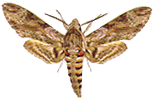|
Agrius convolvuli Linnaeus
Sphinx convolvuli Linnaeus, 1758, Syst. Nat. edn. 10: 490.
Herse convolvuli Linnaeus; Rothschild & Jordan, 1903: 11.
|

Agrius convolvuli ♂
(.65
natural size)
|
Diagnosis. The species can easily be distinguished from similar Sphingini by the
multifasciate hindwings and the pink stripes laterally on the abdomen.
Geographical range. Throughout Old World except higher latitudes.
Habitat preference. The species is probably most common in open habitats in the
lowlands, but has been taken at over 2000m on G. Kinabalu and G. Mulu; it may
show hill-topping tendencies.
Biology. The larvae are highly variable in Java: green, brown or black (Dupont
& Roepke, 1941). Green and brown ones always have oblique lateral stripes; a
dorsolateral streak and pairs of black patches may be present. Black ones always
have yellow dorsal and broad dorsolateral stripes, and white lateral ones;
oblique stripes may be present. The horn is yellowish brown or orange, tipped
with black. Intermediate forms also occur.
Recorded host-plants (Bell & Scott, 1937; Dupont & Roepke, 1941;
Robinson, 1975; Moulds, 1981; Barlow 1982; Miyata, 1983) are: Alocasia,
Colocasia (Araceae); Helianthus (Compositae); Calytegia, Ipomoea, Merremia
(Convolvulaceae);
Arachis, Dolichos, Phaseolus, Vigna (Leguminosae); Abutilon, Hibiscus
(Malvaceae);
Nicotiana (Solanaceae); Tetragonia (Tetragoniaceae).
<<Back
>>Forward <<Return
to Contents page
|

